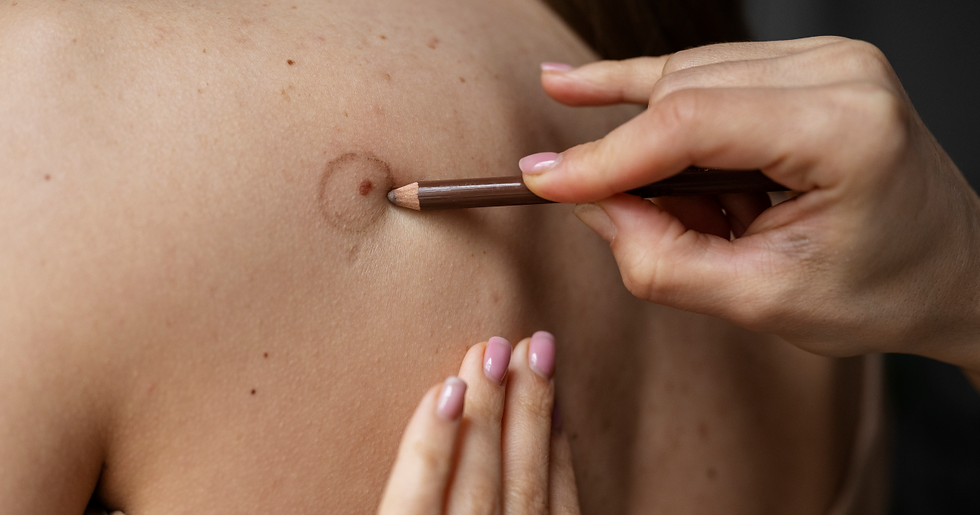May is Skin Cancer Awareness Month
- Northeast Dermatology
- May 2, 2024
- 4 min read

The Most Common Cancer
According to the Skin Cancer Foundation, skin cancer is the most common type of cancer in the United States and worldwide. While there are some individuals who are at a higher risk, anyone can develop skin cancer. Exposure to UV light is the most preventable risk factor for all skin cancers.
Did you know?
One in five Americans will develop skin cancer by the age of 70.
More than two people die of skin cancer in the U.S. every hour.
Having five or more sunburns doubles your risk for melanoma.
When detected early, the five-year survival rate for melanoma is 99 percent.
Non-melanoma Skin Cancer
Non-melanoma skin cancer generally refers to the most frequent skin cancers, basal cell and squamous cell carcinomas. Basal cell carcinoma (BCC) is the most common form of skin cancer. It is estimated that 4.3 million cases of BCC are diagnosed in the U.S. each year, according to the CDC.
The second most common form of skin cancer is squamous cell carcinoma (SCC). The CDC reports there are more than 1 million cases of SCC diagnosed in the U.S. each year.
The diagnosis and treatment of non-melanoma skin cancer is on the rise in the U.S. The rate according to the skin cancer foundation has increased by 77 percent between 1994 and 2014, and continues to increase.
The majority of non-melanoma skin cancers are associated with exposure to UV light, either from the sun or tanning beds.
It is estimated, according to the CDC, that 15,000 people die of SCC in the U.S. each year. This is twice as many as melanoma.
There are certain medications that can increase your risk of SCC. Typically these are immunosuppressive medications.
Organ transplant patients are also at an increased risk of SCC. They are 100 times more likely than a non-organ transplant patient to have a SCC.
Prevention and Detection
Basal cell and squamous cell carcinomas are highly curable if detected early.
Exposure to UV light is the most preventable risk factor for all skin cancers. Avoiding tanning beds, wearing protective clothing, using a broad-spectrum, water-resistant sunscreen with an SPF 30 or higher and seeking shade are great ways to protect one’s skin from harmful rays.
Children should definitely avoid sunburns in childhood. Sunburns can increase their risk of melanoma over their lifetime.
If you notice any spots on your skin that are different from others, are growing or changing in size or color, are not healing, or are itching and bleeding, get them checked out by one of our providers!
Performing regular self-exams can help detect changing spots more quickly.
Melanoma
Melanoma is a cancer of the pigment cells within the skin. This is one of the most dangerous types of cancer because of the ability of these cells to spread within the body (metastasize). Exposure to natural (sun) or artificial (tanning bed) ultraviolet light is the most well-studied risk factor for melanoma. In fact, experiencing five or more blistering sunburns between ages 15 and 20 can increase a person’s melanoma risk by 80 percent. Genetics and immunodeficiencies can also play a role. Patients with a large number of moles, especially if they are irregular in shape, size, and color (atypical moles), are also at higher risk.
What Does Melanoma Look Like?
Dermatologists urge everyone to examine their skin regularly; the first of each month is often a good reminder. The entire body should be examined, even areas that don’t receive sun exposure, and often a partner is needed to help monitor difficult-to-see locations like the back. Cancers, by their nature, are growing, so if you notice a new mole, a mole that looks different than the others on your skin, or one that changes, itches, or bleeds, you should make an appointment to see your dermatologist. Patients with dark skin should also pay close attention to moles that appear on their hands and feet.
The “ABCDE rule” is helpful in identifying the warning signs of melanoma.
Asymmetry – one half of the mole does not match the other half
Border Irregularity – a ragged, notched, or blurred outline of the mole
Color Irregularity – non-uniform pigmentation and the presence of different colors in the mole
Diameter increasing – growth of a mole, especially if more than 6mm (pencil eraser size)
Evolving – the mole is growing and looks different from other moles on the skin
Can Melanoma be Cured?
Yes, but typically only if it is caught in its earliest stage, which often lasts many months. This is why screening and self-detection of melanoma are so important. If you notice an abnormal growth on your skin, do not delay, because catching melanoma early could be the difference between life and death.
Can Melanoma be Prevented?
Most melanoma prevention strategies are centered around the protection of the skin from harmful UV rays. Seek shade when available and avoid the strongest sun rays between 10 AM-2 PM. Wear protective clothing including long-sleeve shirts, wide-brim hats, and sunglasses. Apply sunscreen with an SPF of 30 or above and reapply every 2 hours or after getting wet when active in sunlight. Avoid tanning beds, which have been proven to increase skin cancer rates and promote early aging of the skin. Use a self-tanning product as a safe way to cosmetically darken the skin.
If you find a suspicious mole on your skin or would like to schedule a skin check, get in touch today!









Commentaires